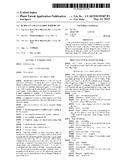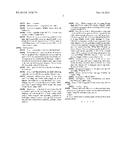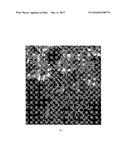Patent application title: Echinacea plant named 'Dixie Blaze'
Inventors:
Harini Korlipara (Canby, OR, US)
Harini Korlipara (Canby, OR, US)
Assignees:
Terra Nova Nurseries, Inc.
IPC8 Class: AA01H500FI
USPC Class:
PLT428
Class name:
Publication date: 2015-05-14
Patent application number: 20150135387
Abstract:
A new and distinct Echinacea plant named `Dixie Blaze` characterized by
an amazing number of inflorescences starting in the first season, very
long bloom time with excellent rebloom, a very upright, compact habit,
bright red orange ray florets surrounding dark cones, ray florets held
horizontally, numerous, strong dark stems, and excellent vigor.Claims:
1. A new and distinct Echinacea plant as herein illustrated and
described.Description:
BOTANICAL DENOMINATION
[0001] Echinacea spp.
VARIETY DESIGNATION
[0002] `Dixie Blaze`
BACKGROUND OF THE INVENTION
[0003] The present invention relates to a new and distinct cultivar of Echinacea and given the cultivar name `Dixie Blaze`. Echinacea is in the family Asteraceae. The new cultivar is part of a planned breeding program for a landscape series with compact habits and profuse inflorescences. The exact parents of this selection are unknown, unnamed, proprietary interspecific hybrids of Echinacea paradoxa, Echinacea purpurea, and Echinacea tennesseensis.
[0004] Compared to Echinacea `Dixie Scarlet` (U.S. Plant patent applied for concurrently), the new cultivar flowers that are more orange.
[0005] This new Echinacea cultivar is uniquely distinguished by:
[0006] 1. an amazing number of inflorescences starting in the first season,
[0007] 2. very long bloom time with excellent rebloom,
[0008] 3. very upright, compact habit,
[0009] 4. bright red orange ray florets surrounding dark cones,
[0010] 5. ray florets held horizontally,
[0011] 6. numerous, strong dark stems, and
[0012] 7. excellent vigor.
[0013] This new cultivar has been reproduced only by asexual propagation (division and tissue culture). Each of the progeny exhibits identical characteristics to the original plant. Asexual propagation by division and tissue culture using standard micropropagation techniques with terminal and lateral shoots, as done in Canby, Oreg., shows that the foregoing characteristics and distinctions come true to form and are established and transmitted through succeeding propagations. The present invention has not been evaluated under all possible environmental conditions. The phenotype may vary with variations in environment without a change in the genotype of the plant.
BRIEF DESCRIPTION OF THE DRAWINGS
[0014] FIG. 1 shows a two-year-old Echinacea `Dixie Blaze` growing in the trial field in full sun in early September in Canby, Oreg.
DETAILED PLANT DESCRIPTION
[0015] The following is a detailed description of the new Echinacea cultivar based on observations of 18-month-old specimens growing in the garden in sun in Canby, Oreg. Canby is in Zone 8 on the USDA Hardiness map. Temperatures range from a high of 95 degrees F. in August to an average of 32 degrees F. in January. Normal rainfall in Canby is 42.8 inches per year in the trial fields in Canby, Oreg. The color descriptions are all based on The Royal Horticultural Society Colour Chart, 5th edition.
[0016] Plant:
[0017] Type.--herbaceous perennial.
[0018] Hardiness.--USDA Zones 4 to 9.
[0019] Size.--grows to about 30 cm to 40 cm wide and 58 cm tall to top of inflorescences.
[0020] Form.--basal clump, with 4 to 9 stems from the base.
[0021] Vigor.--excellent.
[0022] Roots.--fibrous, with many downward growing and few laterals, ivory in color, Yellow White 158D, roots develop easily from cuttings from the crown.
[0023] Stem (flowering):
[0024] Type.--ascending.
[0025] Size.--9 cm to 39 cm to a lateral inflorescence and to 10 mm wide at base.
[0026] Number of flowering stems from the ground.--4 to 9.
[0027] Internode length.--3 cm to 4 cm.
[0028] Surface texture.--strigose.
[0029] Color.--Yellow Green 147B in shade, tinted 187A in sun.
[0030] Leaf:
[0031] Type.--simple.
[0032] Shape.--lanceolate.
[0033] Arrangement.--alternate.
[0034] Blade size.--grows to 9 cm long and 3 cm wide.
[0035] Margins.--mostly entire.
[0036] Apex.--acuminate.
[0037] Base.--attenuate.
[0038] Surface texture.--strigose on both sides.
[0039] Venation.--pinnate, Yellow Green 145C on both sides.
[0040] Color.--topside Green N137A, bottom side closest to Yellow Green 147A.
[0041] Petiole description.--clasping, grows to 6 cm long and 3 mm wide, scabrous, narrow leafy edges which fold upwards, topside Green N137A, bottom side Yellow Green 145C, Greyed Purple 187B on both sides where clasping.
[0042] Inflorescence:
[0043] Type.--composite on terminal stalked heads.
[0044] Flowering stem.--grows to 50 cm tall from the base of the plant to the terminal inflorescence and can grow to 16.5 cm long from the top stem leaf to the base of an inflorescence; unbranched to branched, with 1 to 10 inflorescences per stem; diameter growing to 8 mm wide near the inflorescence; strigose; Yellow Green 147B in shade, tinted 187A in sun.
[0045] Size.--grows to 10.3 cm wide and 6 cm deep as disc enlarges.
[0046] Form.--ray florets held horizontally, reflexing somewhat in very old flowers, mature disc is conic.
[0047] Immature inflorescence (bud).--5 cm wide and 3 cm deep, ray florets held upright at an 40 degrees and rolled up so only the back color shows, Orange Red N34A except tip Greyed Yellow 160B, disc color Greyed Orange 165A except the center where Yellow Green 144A.
[0048] Ray florets.--without pistil or stamen, 20 to 26 in number, grow to 40 mm long and 10 mm wide, oblanceolate with the tip two-to-three-toothed (each acute), entire margins, base attenuate, glabrous on both sides; topside closest to Orange Red 34A; bottom side Greyed Red 182A with Greyed Yellow 160B near tip.
[0049] Disc.--flat becoming conic, becoming 38 mm deep and 35 mm wide with maturity, Greyed Purple 187A in background with bracts Orange 26A with tips Greyed Purple 187A.
[0050] Disc florets.--about 400 in number, each with 1 pistil and 4 stamen, grow to 10 mm long and 2 mm wide, each with one persistent, very stiff linear bract (10 mm long with the top 4 mm Greyed Purple 187C to 4 mm Yellow Green 146B blending to White NN155A on bottom); corolla 6 mm long and 2 mm wide, tubular, 5 lobed, glabrous, Yellow Green 148C with the lobes and base Greyed Red 181B; pistil 10 mm long, ovary 3 mm long, White NN155D with top Yellow Green 144A, style 6 mm long White NN155A, 2-branched stigma spreading 3 mm wide, Greyed Purple 187A; stamen 4.5 mm long, filaments 2 mm long and White NN155B, anthers 2 mm long and Greyed Purple N186A, pollen Yellow 11B.
[0051] Involucral bracts.--in 4 leafy series, area grows to 34 mm wide and 10 mm deep, lobes lanceolate in shape, reflexed, grow to 10 mm long and 4 mm wide, Green N137A, margins strigose, tip acute, strigose on both sides.
[0052] Receptacle.--grows to 12 mm wide and 23 mm deep, White NN155B.
[0053] Bloom period.--June through October in Canby, Oreg.
[0054] Fragrance.--floral, sweet.
[0055] Lastingness.--each inflorescence lasts about two weeks in Canby, Oreg.
[0056] Seeds: 3 mm long and 2.5 mm wide, oval, Brown 200C
[0057] Fertility.--poor.
[0058] Disease and pests: No pests or diseases have been observed on plants grown under commercial conditions in Canby, Oreg. No resistances are known.
User Contributions:
Comment about this patent or add new information about this topic:



